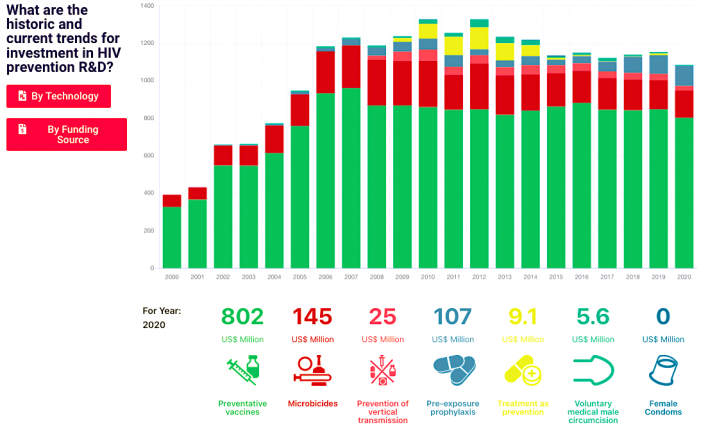Financial support for the research and development (R&D) of HIV prevention declined in 2020, marking a drop for the second year in a row and continuing an eight-year trend of either decreased or flat funding, according to the latest annual report on the topic from AVAC, a global organization focused on HIV prevention.
What’s more, the report highlights that the funding relies almost exclusively on the public sector, particularly the United States, and one philanthropic funder in particular, the Bill & Melinda Gates Foundation.

2020 funding trends in research and development of HIV preventionHIVResourceTracking.org
“These concerning trends in funding come at a promising but very demanding moment in efforts to control the pandemic,” said Mitchell Warren, executive director of AVAC, in a press release about the report. “Funding is declining just as the field confronts a new generation of opportunities and challenges.”
Authors of the report—“HIV Prevention Research and Development Investments Report”—analyzed financial investment trends at 215 funders. This marks the 16th annual report from the Resource Tracking for HIV Prevention R&D Working Group, which is led by AVAC in partnership with the International AIDS Vaccine Initiative (IAVI) and the Joint United Nations Program on HIV/AIDS (UNAIDS).
Key findings include:
- Funding for HIV prevention R&D dropped by $54 million (4.4%) in 2020.
- HIV prevention R&D is highly overdependent on a few key funders, and much of the world is not contributing at the levels seen in prior years.
- Funding dropped in 2020 across a number of key areas of R&D, including preventive vaccines, various forms of pre-exposure prophylaxis (PrEP), voluntary medical male circumcision and prevention of mother-to-child transmission (referred to a vertical transmission). Meanwhile, no funding was invested in female condoms.
- Only two areas of prevention R&D funding showed small increases in funding: microbicides and treatment as prevention (TasP, nowadays more commonly referred to as Undetectable Equals Untransmittable, or U=U).
More data from the report can be found on HIVResourceTracking.org, which includes interactive graphics and compares the 2020 data with previous years.
A new report on #HIVResearchFunding from @HIVpxresearch, @IAVI and @UNAIDS shows that HIV prevention funding drops again. https://t.co/tTbYzMmcH4 pic.twitter.com/kOSX6PFtJL
— AVAC (@HIVpxresearch) December 9, 2021
In related prevention news, beginning in January, HIV clinics in the United States could lose over $100 million each year—notably, those that serve Black, brown, queer and Southern communities. Pharma giant Gilead Sciences, which manufactures several blockbuster HIV treatments, is ending a reimbursement system that helps finance the clinics. The situation stems from federal law 340B, which regulates drug pricing. For more details, see “PrEP Programs Face Devastating Loss of Funding for HIV Prevention.”
To forestall the imminent catastrophe, several members of Congress have introduced bills that establish and fund PrEP programs. To learn more, read “2021 Was a Year of HIV Progress; Now Let’s Focus on PrEP Access.”
Finally, don’t miss this recent PrEP news: the Food and Drug Administration has approved Apretude, an every-other-month injection to prevent HIV.







1 Comment
1 Comment